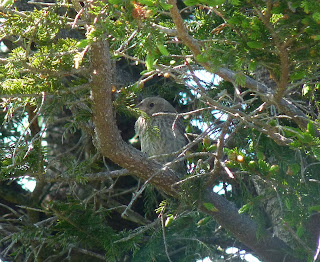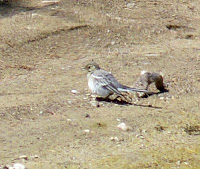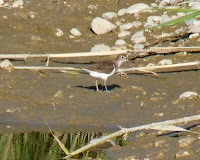A plethora of fantastic birds, of course, inspired the trip, but it would have been worth it for the beauty of the landscape alone. From a good vantage point such as Roan or Mitchel, ridges tinged blue by vegetable volatiles layer their way outwards for miles in all directions like waves on a still forested ocean.
Up close these vistas transform into majestic stands of northern hardwoods or coniferous groves straight out of some fairy tale. And then of course there were the grassy balds with rhododendrons and azaleas in full bloom.
Until last weekend, I had not visited the North Carolina mountains in summer since camp some 15 years ago. The scenery gave me a pleasant nostalgia yet much of the bird life was exciting and new. Familiar birds were, of course, everywhere as well, but many species were ones that I'm only used to seeing in winter. Juncos, for example, were signing...
..and nesting everywhere.
The mountains are known for their warblers and on that front they didn't disappoint (we had 16 species).
At a stop along the Parkway we heard 3 singing Cerulean Warblers and I got great looks at one as it belted out its song. I had wanted to see this bird for ages (lifer #1511!)
After a stop at the highest point east of the Mississippi we headed for our camping spot, Roan Mountain, on the Tennessee border.
But on our way we spotted a Wild Turkey standing by the side of the Parkway and not 2 minutes later a Ruffed Grouse (NC bird #262!). We would hear at least 3 bobwhites singing above Carver's Gap the next morning giving us a sweep of the native terrestrial game birds.
As we walked up the side of Round Bald, a grass-covered mound dotted with patches of spruce, azalea and rhododendron, Jacob Socolar unleashed "The John Fussell Method for Flushing a Vesper Sparrow."
Not a single sparrow flushed, but a moment later we stumbled upon a Vesper Sparrow singing from a patch of short spruce trees (life bird #1512!).
We were surprised to see nearly 10 more actively singing and posturing at invisible territorial barriers along the Appalachian just after sunset. It turns out this bird is well-named as the word "vesper" can be defined as:
"–adjective
I guess it is not a secret that these sneaky birds breed up here, but the following morning we saw one with food in its mouth that we assume it was planning on feeding to nestlings hidden somewhere in the grass.
We also found singing Alder Flycatchers on the bald and down into Carver's Gap quite easily (NC bird #264). We counted at least 10, some of which sang into the late morning.
But we didn't hang around too long, because we had gotten a hot tip about a spot for Golden-winged Warblers over in Tennessee.
Hampton Creek Cove did not disappoint. Not only was there a Golden-winged Warbler actively singing and foraging right near the entrance (though apparently too busy raising a family to stop for a photo) but there were also a couple Willow Flycatchers.
We headed back to Roan for the night and tried some Owling with John Hare, but completely struck out.
The next day we headed for Elk Knob Gamelands hoping to find more Golden-winged Warblers on the NC side of the border. We found loads of perfect habitat, but as soon as we stepped out of the car a ferocious thunderstorm whipped up and blew away all the birds we were after. Well that's not entirely true. We did stumble upon a few Least Flycatchers (NC bird #264) and up at the gap got possibly our best bird of the trip...
Yet it wasn't even a bird at all, just a beetle impaled on a barbed wire fence. But the implications are that a Loggerhead Shrike must be in the area someplace and have plans to return and eat the beetle later. This is a species that Simpson's The Bird of the Blue Ridge Mountains (1992) lists as a: "Rare permanent resident, more frequent from August through March, mostly...at elevations below 3,000 feet; declining in numbers since 1970s." So we found solid evidence of a rare bird at an unexpected time of year well above its expected elevation (4400+ feet at Rich Mountain Gap).
Other interesting finds for the weekend:
A Swainson's Thrush heard singing from near Jane Bald. Simpson (1992) lists this as a rare summer resident on Mount Rogers summit (wherever that is).
A White-eyed Vireo heard singing at 5400 feet at Engine Gap (where we camped). Simpson (1992) lists this as ranging up to 4,000 feet until after late July when it can wander higher.
At least two singing Magnolia Warblers at Roan Mountain; "rare at Roan Mountain" (Simpson 1992).
A Yellow-rumped Warbler seen at Carver's Gap. I had read someplace online that these are known to breed in the mountains albeit in very small numbers.
Ali found about 700 salamanders.
We got all excited about this bird until we realized it was an immature cowbird rather than a crossbill. A flock of what Jacob tells me were crossbills flew over us at Carver's Gap, but this wasn't a satisfactory look for me.
The biggest miss though was Mark Kosiewski and the Meehan brothers who we had planned to meet up with at Roan. Chalk up another bungle to over-reliance on mobile phones (and more importantly, network coverage).
Plenty of bird species left to see up there to bring me back for another trip sometime.
But do I really need birds as excuse to make this kind of a camping trip?
| An Alder Flycatcher enjoying the view |
Until last weekend, I had not visited the North Carolina mountains in summer since camp some 15 years ago. The scenery gave me a pleasant nostalgia yet much of the bird life was exciting and new. Familiar birds were, of course, everywhere as well, but many species were ones that I'm only used to seeing in winter. Juncos, for example, were signing...
 |
| Dark-eyed Junco |
 |
| Dark-eyed Junco nest |
 |
| Yellow Warbler |
At a stop along the Parkway we heard 3 singing Cerulean Warblers and I got great looks at one as it belted out its song. I had wanted to see this bird for ages (lifer #1511!)
 |
| Chestnut-sided Warbler |
But on our way we spotted a Wild Turkey standing by the side of the Parkway and not 2 minutes later a Ruffed Grouse (NC bird #262!). We would hear at least 3 bobwhites singing above Carver's Gap the next morning giving us a sweep of the native terrestrial game birds.
As we walked up the side of Round Bald, a grass-covered mound dotted with patches of spruce, azalea and rhododendron, Jacob Socolar unleashed "The John Fussell Method for Flushing a Vesper Sparrow."
| Jacob hoping to flush a Vesper Sparrow |
 |
| Vesper Sparrow |
We were surprised to see nearly 10 more actively singing and posturing at invisible territorial barriers along the Appalachian just after sunset. It turns out this bird is well-named as the word "vesper" can be defined as:
"–adjective
of, pertaining to, appearing in, or proper to the evening."
I propose a name change from Evening Grosbeak to "Vesper Grosbeak."
I guess it is not a secret that these sneaky birds breed up here, but the following morning we saw one with food in its mouth that we assume it was planning on feeding to nestlings hidden somewhere in the grass.
 |
| Vesper Sparrow with food |
We also found singing Alder Flycatchers on the bald and down into Carver's Gap quite easily (NC bird #264). We counted at least 10, some of which sang into the late morning.
 |
| Alder Flycatcher |
Hampton Creek Cove did not disappoint. Not only was there a Golden-winged Warbler actively singing and foraging right near the entrance (though apparently too busy raising a family to stop for a photo) but there were also a couple Willow Flycatchers.
We headed back to Roan for the night and tried some Owling with John Hare, but completely struck out.
The next day we headed for Elk Knob Gamelands hoping to find more Golden-winged Warblers on the NC side of the border. We found loads of perfect habitat, but as soon as we stepped out of the car a ferocious thunderstorm whipped up and blew away all the birds we were after. Well that's not entirely true. We did stumble upon a few Least Flycatchers (NC bird #264) and up at the gap got possibly our best bird of the trip...
 |
| Evidence of a Loggerhead Shrike? |
Other interesting finds for the weekend:
A Swainson's Thrush heard singing from near Jane Bald. Simpson (1992) lists this as a rare summer resident on Mount Rogers summit (wherever that is).
A White-eyed Vireo heard singing at 5400 feet at Engine Gap (where we camped). Simpson (1992) lists this as ranging up to 4,000 feet until after late July when it can wander higher.
At least two singing Magnolia Warblers at Roan Mountain; "rare at Roan Mountain" (Simpson 1992).
A Yellow-rumped Warbler seen at Carver's Gap. I had read someplace online that these are known to breed in the mountains albeit in very small numbers.
Ali found about 700 salamanders.
 |
| Immature Brown-headed Cowbird (not a Red Crossbill) |
The biggest miss though was Mark Kosiewski and the Meehan brothers who we had planned to meet up with at Roan. Chalk up another bungle to over-reliance on mobile phones (and more importantly, network coverage).
Plenty of bird species left to see up there to bring me back for another trip sometime.
But do I really need birds as excuse to make this kind of a camping trip?
























